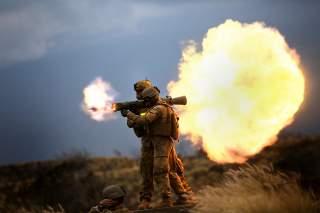This Is How to Kill a Tank
The Carl Gustav and the AT4 are some of the most popular anti-tank systems in the world.
The Carl Gustav and the AT4 are some of the most popular anti-tank systems in the world. While the “dumb” rockets both launchers fire may seem outdated in a world full of anti-tank guided missiles, often times the additional weight and complexity a guided missile brings is unnecessary for a task.
This has been proven by the effective use of the Soviet RPG-7 series of launchers by various adversaries through the years. While some companies in the West now made a modernized clone of this launcher, the de-facto standard weapon of the same class for NATO for many years was the Carl Gustav recoilless rifle.
While significantly heavier than the RPG-7, the Carl Gustav is largely considered to be more accurate and easier to shoot, since the projectile doesn’t move in the reverse direction of the wind (as finned projectiles, including those shot by the RPG-7, will do).
Both launchers have received updates for the modern era. The standard telescopic sight provided with the Carl Gustav has seen updates to its reticle between the M2, M3, and now M4. The Gustav M4 is also offered with an automatic laser rangefinding sight with a ballistic computer for even more precise shots.
Likewise, the RPG-7 has had the drop compensator of its PGO-7V telescopic sight changed to account for newer ammunition types (such as the PG-7VR tandem warhead round).
But while updates to the telescopic reticle are common, the Carl Gustav M4 is notable for totally doing away with iron sights as the backup sighting system, eschewing them in favor of a small “micro” red dot sight.
This micro red dot is attached to a colored rotating drum, which allows the gunner to dial in the red dot for up to four types of ammunition. The drums can be swapped out if more kinds of ammunition are desired to be used.
Compared to the iron sights of the RPG-7V2, the latest version adopted by the Russian military, the Gustav M4’s sighting apparatus is practically space age. The RPG’s iron sights still consist of vertically sliding notch and post sights, which require the gunner to alight the two metal sights with the target and shoot. The red dot featured on Gustav makes gunner largely a point and shoot affair.
Interestingly, the red dot on the Carl Gustav M4 is made by Meopta, a Czech company. When asked why the Saab chose the Meopta sight as opposed to a sight by Aimpoint, a company also from Sweden known for their excellent red dots, a Saab representative said that Meopta was able to fulfill the price and quality specifications successfully.
But Saab didn’t only update the Carl Gustav M4. The AT4 series of launchers, also made by Saab are also receiving a sight upgrade as part of the latest iteration of the weapon produced for the French military under the name Roquette Nouvelle Generation (Roquette NG).
The “confined space” anti-backblast technology that was first added on the AT4 CS has now become standard across all launchers produced. But also, the hole and trident sights of the AT4 have been swapped out for a simple “fold out” micro red dot.
Unlike the dot sight featured on the Carl Gustav M4, the sight is meant to be cheap and single use, as it will be disposed of with the launcher. It resembles an Aimpoint red dot sight: a battery tube with an on/off brightness adjustment switch is positioned parallel to the sight tube.
The range elevation has been moved from a sliding scale on the rear sight to a vertically adjustable drum attached to the red dot. Like with the Carl Gustav M4, the upgrade appears to make the new launcher significantly faster to put into action.
With the old version of the AT4, to get the launcher ready to fire, the soldier would first open up two sliding sight covers to ready the iron sights, then cock the launcher, then select the correct sight aperture, before lining up the sights to get ready fire.
Recommended: What Will the Sixth-Generation Jet Fighter Look Like?
Recommended: Imagine a U.S. Air Force That Never Built the B-52 Bomber
Recommended: Russia's Next Big Military Sale - To Mexico?
Recommended: Would China Really Invade Taiwan?
With the new version, the gunner just needs to fold out the sight and turn it on, which can be done in one motion, before cocking the launcher and being ready to fire. It also can be used under night vision, unlike earlier iron sights.
The two updates to red dots may seem trivial but could prove important in combat. With anti-tank weapons, accuracy and speed on the first shot is critical. While optics technologies for close combat on service rifles have advanced leaps and bounds, AT launchers have remained in the Cold War era. Saab’s update brings them into the twenty-first century and likely will set the pace for other manufacturers to begin replacing the remaining launchers with iron sights.
Charlie Gao studied political and computer science at Grinnell College and is a frequent commentator on defense and national-security issues.

